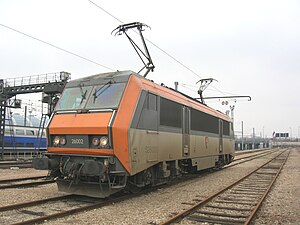SNCF BB 26000
| BB 26000 | |
|---|---|
|
BB 26002
|
|
| Numbering: | Original company numbers: 26001–26234 Number ranges since the breakdown of the SNCF: VFE 126xxx CIC 226xxx FRET 426xxx TER 526xxx |
| Manufacturer: | Alstom |
| Year of construction (s): | 1988-1998 |
| Axis formula : | B'B ' |
| Length over buffers: | 17,710 mm |
| Service mass: | 88.8 t |
| Wheel set mass : | 22.2 t |
| Top speed: | 200 km / h |
| Continuous output : | 5600 kW |
| Starting tractive effort: | 320 kN |
| Performance indicator: | 63 kW / t |
| Power system : | 25 kV / 50 Hz AC; 1.5 kV DC |
| Number of traction motors: | 2 |
| Drive: | Hollow shaft |
| Brake: | electronically controlled electrical resistance brake; Air brake |
| Train control : | RS (Crocodile) and KVB |
The series BB 26000 is an electric general-purpose locomotive of the French National Railways (SNCF) . It was built between 1988 and 1998 by Alstom - at that time still operating as Alsthom - in Belfort .
history
Since the 1970s, the SNCF electric locomotives had with by thyristors controlled phase control procured. These were the series BB 7200 as a pure direct current locomotive , the BB 15000 as a pure alternating current locomotive and the BB 22200 as a two-system locomotive. For the sake of easier maintenance and more flexible use, however, it was decided during the planning and production of these two series that future electric locomotives would only be available in two-system versions. Accordingly, the BB 22200, which was manufactured from 1976, was already designed as a two-system locomotive.
In the first half of the 1980s, the SNCF made the decision that the following electric locomotive types should be equipped with inverter-controlled three-phase motors. In contrast, for example, to the West German locomotive builders who developed the 120 series around the same time , France initially relied on synchronous motors instead of asynchronous motors .
The first locomotive of this new series, designated BB 26000, was presented on April 1, 1988. 234 units had been produced by 1998. Starting with road number 26188, the machines were equipped with a triple headlights as standard .
The BB 26000 is well known under the artificial name Sybic ; This was from sy nchrone for synchronous motors and bic ourant formed for the two-system capability.
construction
The BB 26000 is mainly made of steel and has a very unique appearance due to its angular design. Particularly noteworthy in terms of its construction is the fact that, like some earlier French electric locomotives, it has so-called monomotor bogies , in which only one large traction motor drives all axles of the respective bogie via a downstream gear unit. The tractive effort is transmitted between the locomotive body and the bogies via low-lying pull and push rods. The primary suspension is done with coil springs and the secondary suspension with rubber-steel blocks. The power transmission from the respective drive motor or from the transfer case to the wheel sets takes place via hollow shaft rubber ring spring drives.
In the electrical part , liquid-cooled traction converters based on GTO thyristors are used. These work with an intermediate circuit voltage of 1.5 kV direct current and can therefore be fed directly from the overhead line during operation in the French direct current network. The main transformer is connected upstream of them in the alternating current network .
Two different current collectors are installed on the roof, one each for direct current (with four contact strips) and alternating current (with two contact strips).
For operation, the train driver has a simple manual traction and braking force control, the so-called "dispositif de vitesse imposée" (a speed control similar to the German AFB , but without coupling with the pneumatic brake ) and as an aid for operation in the 1.5- kV network provides a power limitation to limit the current consumption. Controls for direct and indirect brakes are also provided. The BB 26000 has on-board units for the RS or “Crocodile” and KVB train control systems .
commitment
It was originally planned to procure 264 locomotives of this series, of which the last 30 should also have received the necessary technical equipment for operation in Italy . However, this project was abandoned and the procurement of locomotives suitable for Italy, which were primarily intended to haul freight trains, was postponed until the successor series BB 36000 . So in the end 234 BB 26000 were built. With the subdivision of the SNCF into different business areas, the operating portfolio of this series was also divided. The SNCF Fret freight division received the largest individual share of 139 locomotives. 61 went to the long-distance transport division VFE, 20 to the CIC division, which is responsible for supraregional transport, and 14 to the regional transport division TER.
Since 2014, BB 26000s have been increasingly decommissioned and some of them have already been scrapped, especially at the freight transport division SNCF Fret. In June 2020, 170 of the 234 built locomotives are still in use.
Web links
- SYBIC picture galleries on the European Railway Server Railfaneurope.net
- Florent Brisou Railway Site (French only)
Individual evidence
- ↑ Le nouveau troisième œil des locos in: La Vie du Rail, 2533/1996, p. 8.


